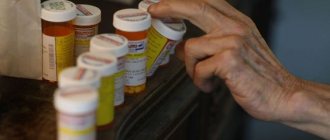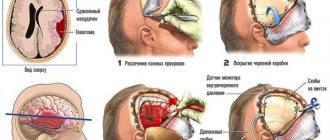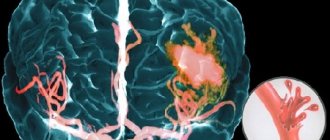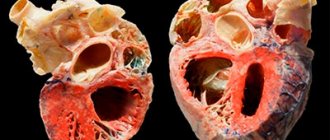Headache occurs in the form of episodic attacks or worries the patient constantly. Attacks of headaches may be accompanied by pain in the eyes, ripples before the eyes, and the sensation of flies flying. These are symptoms of serious diseases that doctors at the Yusupov Hospital identify using modern instrumental and laboratory research methods.
Neurologists, therapists, and oncologists treat patients. Professors and doctors of the highest category at a meeting of the expert council discuss all cases of severe headaches and eye pain that are not amenable to drug therapy. Leading cephalgologists (specialists in the field of headache treatment) collectively develop further tactics for patient management.
Types and causes of pain in the head and eyes
Most often, headaches in the forehead and eyes occur after emotional breakdowns. Many patients experience it in the evening, when the work day ends. In most cases, the cause of pain is simple overwork.
Often the headache radiates to the eyes. Sometimes, first there are ripples in the eyes, then a headache. The eyeballs may first become tense, and then the pain moves to the forehead. Floaters, flickering before the eyes and headache are symptoms of various diseases:
- glaucoma (increased intraocular pressure);
- migraine;
- myopia (myopia);
- arterial hypertension (high blood pressure);
- damage to soft tissues and bones of the head;
- traumatic brain injury.
A headache in the forehead area can occur due to eating unhealthy foods. These are chocolate, tea, coffee, which contain a large amount of caffeine, nuts, cheese, and processed meats. Headache pressing on the eyes after drinking alcohol and smoking. Head pain is caused by the following diseases:
- migraine;
- hypertonic disease;
- diseases of the organs of vision;
- brain tumors;
- Horton's syndrome;
- vegetative-vascular dysfunction;
- encephalitis;
- stroke.
Treatment
Before prescribing treatment, the ophthalmologist will conduct an examination and make a diagnosis. As a rule, the main stages are measuring intraocular pressure, examining the fundus, and examining with a slit lamp. This set of examinations allows you to identify the main and most common eye diseases.
In the case of glaucoma, special medications will need to be dripped into the eyes to reduce intraocular pressure. In most cases, you will need to prepare for surgery - glaucoma does not respond to conservative treatment.
If the pain is caused by an inflammatory disease, then you will need to identify the pathogen and start taking appropriate medications: antibacterial or antiviral.
Treatment for pain caused by fatigue involves following basic visual hygiene recommendations. The patient will have to be more attentive to his health. This pathology is most often found among office workers, and it has even been called visual fatigue syndrome. An ophthalmologist may prescribe eye exercises and recommend coming for preventive examinations.
How to help yourself with a headache
If a headache radiates to the eyes after hard work, you should rest well, take a walk in the fresh air, and give yourself an acupressure massage. You can take a warm bath with chamomile infusion added to the water. Take a break from working at the computer or watching TV
Give yourself a head massage. Relax, drink warm milk with honey, tea with lemon balm. Do simple exercises to relieve headaches:
- sit on a chair, keep your back straight and your head free;
- without effort, just under the influence of gravity, tilt it towards your chest;
- stay in this position for twenty seconds; take a break for 30 seconds;
- Bend again for 20 seconds.
Repeat the exercise 15-16 times.
The second exercise is done in the following sequence:
- sitting or standing, raise your hands to your head;
- the thumbs of each hand are pressed to the zygomatic arches, with the remaining fingers clasping the back of the head;
- look up;
- while inhaling, try to throw your head back for 10 seconds, while holding it with your hands;
- while exhaling, look down for 6-8 seconds;
- tilting your head to your chest as much as possible, stretch but do not strain the neck muscles.
Repeat the inhale-exhale cycle 5-6 times.
To relieve headaches coming from the cervical spine, rehabilitation experts recommend performing the following exercise:
- sitting on a chair, with one hand clasp your head from above on the side in which the pain is felt more strongly;
- Place the index finger at the level of the beginning of the ear;
- With a little hand effort, turn your head to the “healthy” side;
- Press your free palm from below to your chin and cheek;
- while inhaling for 10 seconds, looking down, press your chin to your lower palm against its resistance;
- As you exhale, relax for 6-8 seconds and look up.
- repeat the exercise 5-6 times, slightly changing the turn of the head.
Signs and symptoms of presyncope: dizziness, nausea
Symptoms of presyncope are characterized by sudden development, which is usually provoked by certain factors. A stuffy room, tight clothing, stressful situations, excessive physical activity, eating - all this can contribute to the onset of an attack.
The most characteristic symptom of presyncope is dizziness, which may be accompanied by nausea. This indicates disturbances in the functioning of the human autonomic system.
There is a certain risk group of people for whom the presyncope may be permanent. These are people suffering from hypotension (low blood pressure), chronic anemia (low hemoglobin level in the blood, less than 100 units), bradycardia (low heart rate, less than 40 beats).
Any of the described signs is a serious reason to see a doctor. But, since an attack of pre-fainting can occur at any time and in any place, it is necessary to have at least a general understanding of how to provide first aid to the victim or yourself at home.
Flickering in the eyes and headache
The main cause of flicker in the eyes and headaches is retinal detachment and rupture. Sharp flashes of light are the result of tension in the eye membrane. After a rupture of the capillaries and retina, a person sees many black dots.
Vitreous detachment also causes tension on the retina. It comes in back and front. The vitreous body is divided into a gel and a liquid part, which passes under the membrane and “disconnects” it from the retina. The main sign of the pathology is “flying flies”. They can be seen when looking at the sun, snow in sunny weather, or blue sky.
Chorioretinitis is inflammation of the vessels of the retina of the eye. The development of the disease is caused by:
- infectious diseases;
- increased levels of radiation;
- allergy;
- intoxication;
- injuries and damage to the organs of vision;
- autoimmune conditions;
- decreased immunity after long-term treatment or in HIV-infected patients.
Chorioretinitis can be congenital. Symptoms of the disease include darkening of the eyes and decreased visual acuity. The patient cannot determine the size of objects; it is difficult for him to navigate in low light. Ophthalmologists at the Yusupov Hospital use the latest diagnostic equipment from leading global manufacturers to examine patients and apply innovative treatment methods.
How is pneumonia diagnosed?
If a child suffers from the disease, you should seek examination from a pediatrician. If you are an adult, make an appointment with a therapist who will refer you to a specialist if necessary. The doctor will conduct an external examination, collect anamnesis, study the medical history and learn about the symptoms of the disease.
You will be sent for laboratory tests:
- General blood analysis;
- General urine analysis;
- Sputum analysis is carried out to determine the inflammatory process in the body, as well as the causative agent of pneumonia and its sensitivity to antibiotics.
Among the diagnostic research methods you will be prescribed:
- Chest X-ray - shadows appear in the images in areas of tissue damage;
- Computed tomography and magnetic resonance imaging are used as additional measures when other methods do not allow an accurate diagnosis.
Eye spots and headaches
The main reason why a person experiences ripples in the eyes, and then a headache, is the compression of the blood vessels. This happens when the weather changes, atmospheric pressure changes, or oxygen starvation. Floaters “fly” before the eyes and a headache appears after stress. The cause of headaches and dizziness is nervous exhaustion, deficiency of essential substances and microelements, and the presence of bad habits.
In this case, the pain goes away after rest. But ripples and flickering of spots before the eyes, a headache may be the first signs of a tumor, diseases of the cardiovascular system, or vegetative-vascular dysfunction. If, after rest, the ripples and flickering of spots before your eyes, the headache does not go away, make an appointment by calling the Yusupov Hospital. In each case of headache, neurologists first determine the type of pain, identify its cause and eliminate it, stop the pain attack and carry out therapy, the purpose of which is to prevent subsequent headache attacks.
How coronavirus affects the human brain
Scientists around the world, based on the results of MRI diagnostics of patients with coronavirus and data from pathological studies of sick patients who died from COVID-19, conclude that Covid significantly affects the human brain.
How the new type of coronavirus infects cells in the brain and spinal cord has not yet been fully studied. But it has already been proven that the SARS-CoV-2 penetrates host cells through the interaction of its own S protein with the human ACE2 . Thus, on the cells of the terminal nerve located next to the olfactory epithelium of the nose, there are a large number of ACE2 receptors.
Presumably, the SARS-CoV-2 virus enters the brain using terminal nerve cells.
Scientists conducted studies directly on brain cells and came to the conclusion that neurons and cells of the brain and spinal cord - astrocytes - are also susceptible to infection through the mechanism of coronavirus binding to ACE2 receptors. This means that virus particles penetrate into brain cells and cause disruption of its functioning.
traces of viral proteins were found in the brain tissue of infected patients . Thus, coronavirus, entering brain cells, leads to inflammation of brain tissue and neuronal degeneration (death of neurons and loss of connections between them).
Important! Information from the article cannot be used for self-diagnosis and self-medication! Only a doctor can prescribe the necessary examinations, establish a diagnosis and draw up a treatment plan during a consultation!
There is an assumption that the SARS-CoV-2 virus can enter the brain through blood vessels. Researchers have found that Covid affects the blood vessels of the brain by detecting virus particles in the walls of blood vessels. Scientists have determined how Covid affects blood vessels by studying post-mortem human brain tissue.
It turned out that the ACE2 protein, which the coronavirus binds to, is widely represented in all blood vessels of the frontal cortex of the brain. There is a blood-brain barrier between the blood and brain cells. Its main function is to protect nervous tissue from microorganisms and toxins circulating in the blood. Researchers have found that in the presence of the S protein of the SARS-CoV-2 virus, the permeability of the blood-brain barrier is disrupted. One of the main symptoms confirming this fact is hyposmia or anosmia (partial or complete loss of smell).
The results of MRI diagnostics of patients who have had COVID-19 indicate microstrokes and leukoencephalopathy (damage to the white matter that forms the basis of the brain), leading to the destruction of the protective layer of neurons in the central and/or peripheral nervous system.
Research has shown that coronavirus significantly affects cellular aging, thereby accelerating neurodegenerative pathologies (gradual decrease in the number of nerve cells), such as Parkinson's disease, Alzheimer's disease, multiple sclerosis and others.
The state of the human nervous system is also affected by impaired cerebral circulation, oxygen starvation, and respiratory failure, which occurs against the background of damage to the human lungs by the SARS-CoV-2 virus.
All these complications on the brain after coronavirus lead to the development of mental and neurological disorders.
What to do if you feel faint: first aid
All first aid techniques during a pre-fainting state are aimed at preventing the onset of full-fledged fainting. Let's look at all the necessary steps in detail.
- The first is to provide oxygen access to the room, and, if possible, take a comfortable position. Remove all objects that put pressure on the chest and neck (scarf, tight collar, tie). To better saturate the blood with oxygen, it is necessary to take rhythmic inhalations and exhalations. If the breathing process is difficult, ammonia will help. A sweet, warm drink in the form of tea also helps relieve an attack. If you suspect evaporation of harmful substances in the room or a gas leak, you should quickly leave the building and go outside.
- After the crisis has passed, the body must be provided with the required amount of fluid, which involves consuming at least 2.5 liters of water per day. Taking drugs such as Asparkam and Panangin will normalize the balance of electrolytes in the blood and ensure normal blood supply to all organs. And, of course, it is necessary to establish the cause of the pathology.
- If you have chronic fatigue syndrome, you must take the necessary vitamins and minerals and ensure all conditions for normal work and rest. In case of hypotension or anemia, the cause of this condition should be immediately determined. Since some pathologies require immediate medical attention.
Everything we talked about in this article needs to be known and remembered by every person. Because presyncope attacks develop suddenly, which can pose a serious threat to life. After all, at this moment a person can cross the roadway or drive a car. The most important thing when providing first aid to yourself or your loved ones is to prevent full-blown fainting from developing.
Primary appointment with a neurologist: 1850 RUR.
Sign up Online 5% discount when registering from the site










